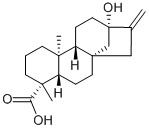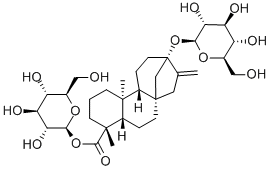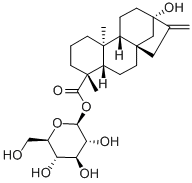Steviol
Synonym(s):(4α)-13-Hydroxykaur-16-en-18-oic acid;(4α)-13-Hydroxykaur-16-en-18-oic acid hydrate;ent-13-Hydroxykauran-16-en-19-oic acid;NSC 226902
- CAS NO.:471-80-7
- Empirical Formula: C20H30O3
- Molecular Weight: 318.45
- MDL number: MFCD00210558
- EINECS: 260-975-5
- SAFETY DATA SHEET (SDS)
- Update Date: 2025-12-26 16:58:18

What is Steviol?
Description
Steviol is a diterpene found in the leaves of Stevia rebaudiana, a member of the sunflower family that is native to Paraguay and Brazil. For centuries, natives of those countries have used its leaves as a sweetener.? E. Mosettig and W. R. Nes at the National Institutes of Health (NIH; Bethesda, MD) produced it in the lab using enzymes to hydrolyze its glycoside stevioside in 1955. In the early 1960s, F. Dolder et al. at NIH and H. Vorbrueggen and C. Djerassi at Stanford University determined steviol''s structure and stereochemistry.
These days, the product stevia prepared from S. rebaudiana leaves has become popular as a “natural” sweetener in place of such synthetic sweeteners as saccharin, aspartame, and sucralose.
The US Food and Drug Administration banned the import of stevia in 1991 because incomplete toxicology studies did not provide sufficient information on possible harmful effects. It was cleared for some uses in 1995, but not until 2008 did FDA approve a steviol glycoside for use as a sweetener.
The Uses of Steviol
Steviol is an aglycone of the natural sweetener Stevioside (90%, S686730) and is found to be highly mutagenic compared to Stevioside.
The Uses of Steviol
Has been proposed as non-nutritive sweetening agent.
What are the applications of Application
Steviol is an inhibitor of hOAT1 and hOAT3 organic anion transporters
Definition
ChEBI: Steviol is an ent-kaurane diterpenoid that is 5beta,8alpha,9beta,10alpha-kaur-16-en-18-oic acid in which the hydrogen at position 13 has been replaced by a hydroxy group. It has a role as an antineoplastic agent. It is a tetracyclic diterpenoid, a tertiary allylic alcohol, a monocarboxylic acid, a bridged compound and an ent-kaurane diterpenoid. It is a conjugate acid of a steviol(1-).
Health Hazard
Steviol has been reported to be mutagenic.Wide use of stevia in Japan for >30 years did not produce any known deleterious side effects. In Japan, enzymatically glycosylated blend of stevioside and rebaudioside A, which appears to impart a cleaner taste profile, is also available commercially.
Biochem/physiol Actions
Steviol is an inhibitor of hOAT1 and hOAT3 organic anion transporters. Human organic anion transporter hOAT1 belongs to a superfamily of organic anion transporters, which play critical roles in the body disposition of clinically important drugs including anti-HIV therapeutics, anti-tumor drugs, antibiotics, anti-hypertensives, and anti-inflammatories. Steviol is a useful tool for studying renal drug clearance.
Properties of Steviol
| Melting point: | 215° |
| alpha | D -94.7° |
| Boiling point: | 464.5±45.0 °C(Predicted) |
| Density | 1.17±0.1 g/cm3(Predicted) |
| storage temp. | Sealed in dry,2-8°C |
| solubility | DMSO: >10mg/mL |
| form | powder |
| pka | 4.65±0.60(Predicted) |
| color | white to tan |
| Stability: | Light Sensitive |
Safety information for Steviol
| Signal word | Warning |
| Pictogram(s) |
 Exclamation Mark Irritant GHS07 |
| GHS Hazard Statements |
H302:Acute toxicity,oral |
| Precautionary Statement Codes |
P280:Wear protective gloves/protective clothing/eye protection/face protection. P305+P351+P338:IF IN EYES: Rinse cautiously with water for several minutes. Remove contact lenses, if present and easy to do. Continuerinsing. |
Computed Descriptors for Steviol
| InChIKey | QFVOYBUQQBFCRH-ZPNQOMQUSA-N |
New Products
4,4-Difluoropiperidine hydrochloride tert-butyl 9-methoxy-3-azaspiro[5.5]undecane-3-carboxylate Indole Methyl Resin N-Isopropylurea N,N-Dicyclohexylcarbodiimide(DCC) MELDRUMS ACID 5-METHYLISOXAZOLE-4-CARBOXYLIC ACID Magnessium Bis glycinate Zinc ascorbate 1-bromo-2-butyne 2-acetamidophenol 9(10H)-anthracenone Erythrosin B, 4-Piperidinopiperidine 2-((4-morpholinophenylamino) (methylthio) methylene) malononitrile 2,4-dihydroxybenzaldehyde 3-(4-morpholinophenylamino)-5-amino-1H-pyrazole-4-carbonitrile Methyl 2-methylquinoline-6-carboxylate 2,6-dichloro-4-nitropyridine 4-Bromo-2-chlorobenzonitrile 2-(benzylamino)acetic acid hydrochloride 4-(tert-Butoxycarbonylamino)but- 2-ynoic acid 3,4-dihydro-2H-benzo[b][1,4]dioxepine 1-Phenyl-1-cycloprppanecarboxylicacidRelated products of tetrahydrofuran








You may like
-
 Steviol 95% CAS 471-80-7View Details
Steviol 95% CAS 471-80-7View Details
471-80-7 -
 Steviol hydrate CAS 471-80-7View Details
Steviol hydrate CAS 471-80-7View Details
471-80-7 -
 3-(4-amino-1-oxoisoindolin-2-yl)-1-methylpiperidine-2,6-dione 98%View Details
3-(4-amino-1-oxoisoindolin-2-yl)-1-methylpiperidine-2,6-dione 98%View Details -
 614-19-7 98%View Details
614-19-7 98%View Details
614-19-7 -
 20677-73-0 (2,2-diethoxyethyl)methylamine 98%View Details
20677-73-0 (2,2-diethoxyethyl)methylamine 98%View Details
20677-73-0 -
 3-(4-(hydroxyamino)-1-oxoisoindolin-2-yl)piperidine-2,6-dione 98%View Details
3-(4-(hydroxyamino)-1-oxoisoindolin-2-yl)piperidine-2,6-dione 98%View Details -
 57381-49-4 2-bromo-4-chlorobenzonitrile 98%View Details
57381-49-4 2-bromo-4-chlorobenzonitrile 98%View Details
57381-49-4 -
 4,6-dichloropyrimidine-5-carbaldehyde 98%View Details
4,6-dichloropyrimidine-5-carbaldehyde 98%View Details
5305-40-8
